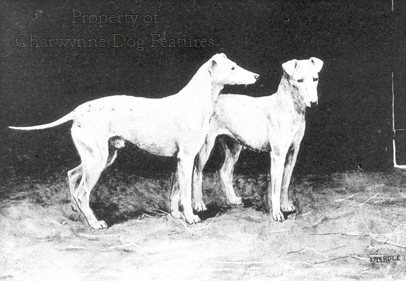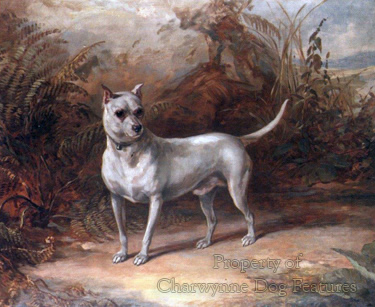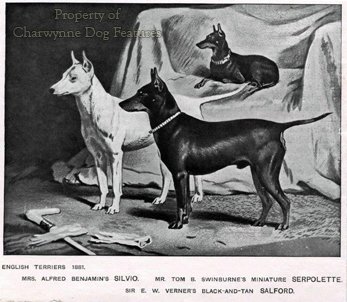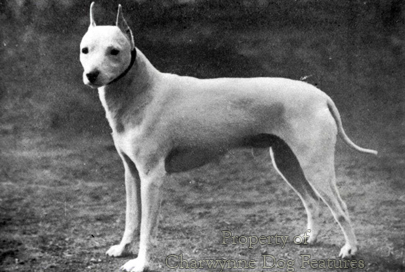801 ENGLISH WHITE - A LOST ARISTOCRAT
THE ENGLISH WHITE - THE LOST ARISTOCRAT OF THE TERRIER BREEDS
by David Hancock
 For the Australians, the Germans, the Czechs, the Russians and now the Japanese and the Brazilians to have a national terrier and not the English is an insult! Even the Tibetans have one - at least by name! As did the Maltese, for a while, admittedly a Toy breed. Yet we did once have an English terrier, not a Toy, by name: the English White Terrier, once so well known and bred so true to type that a restoration would be justified and a regrettable gap in the list of terrier breeds filled. Writing in his "Terriers" of 1922, Darley Matheson recorded: "The writer would like to see really serious attempts made to revive the English white terrier, because it is a type, or rather variety, of dog which makes an excellent companion..." I support that and was interested to read of his recommended blend to resurrect the breed: a white Bull Terrier bitch to a white Whippet dog, with a further outcross to the Manchester Terrier. He envisaged a 15 to 18lb dog and outlined a likely Breed Standard. I suspect that the English White Terrier was, until the late 19th century, a distinct breed-type favoured by the working classes, especially by sweeps, pugilists and rat-catchers. The advent of dog shows brought about the pursuit of a more refined dog and this desire, closely followed by the ban on ear-cropping, led to the loss of a breed that should have become a national canine treasure.
For the Australians, the Germans, the Czechs, the Russians and now the Japanese and the Brazilians to have a national terrier and not the English is an insult! Even the Tibetans have one - at least by name! As did the Maltese, for a while, admittedly a Toy breed. Yet we did once have an English terrier, not a Toy, by name: the English White Terrier, once so well known and bred so true to type that a restoration would be justified and a regrettable gap in the list of terrier breeds filled. Writing in his "Terriers" of 1922, Darley Matheson recorded: "The writer would like to see really serious attempts made to revive the English white terrier, because it is a type, or rather variety, of dog which makes an excellent companion..." I support that and was interested to read of his recommended blend to resurrect the breed: a white Bull Terrier bitch to a white Whippet dog, with a further outcross to the Manchester Terrier. He envisaged a 15 to 18lb dog and outlined a likely Breed Standard. I suspect that the English White Terrier was, until the late 19th century, a distinct breed-type favoured by the working classes, especially by sweeps, pugilists and rat-catchers. The advent of dog shows brought about the pursuit of a more refined dog and this desire, closely followed by the ban on ear-cropping, led to the loss of a breed that should have become a national canine treasure. 
In his Show Dogs of 1925, Theo Marples wrote that "there is little doubt that the breed is a Lancashire production, where it has for the most part abounded." The breed was not classified separately by the KC until the early 1890s. Three of the most prominent early fanciers all came from Bolton in Lancashire. In The Kennel Gazette of January 1889, a contributor using the nom de plume 'Union Jack' wrote: "I am glad to see that efforts are being made to make white English terriers more popular. This beautiful breed has had a great many ups and downs and many of them quite in a wrong direction. We shall never see better stamp of terriers than old Tim and Godfree's Prince, the winners at Birmingham in 1865 and at Islington in 1869..." This hints at a show career for the breed of around half a century. The disappearance altogether of this much-admired breed from the KC's lists is a sharp reminder for the worthy people, including those at the KC, now giving attention to the list of vulnerable native breeds, most of them in the Terrier Group.
Italian Greyhound Blood
In his Dogs and all about them, of 1914, Robert Leighton wrote on the breed: “At the Kennel Club show of 1909 there was not a single specimen of the breed on view, nor was one to be found at Edinburgh, Birmingham, Manchester, or Islington, nor at the National Terrier Show at Westminster. It is a pity that so smart and beautiful a dog should be suffered to fall into such absolute neglect. One wonders what the reason of it can be.” Vero Shaw complained in 1879 about the introduction of Italian Greyhound blood, leading to a loss of terrier characteristics. He quoted Mr. James Roocroft of Bolton, a prominent breeder of English Whites, as making adverse comments about some specimens showing "in a marked manner a cross of the snap-dog breed". He described the breed as 18" at the shoulder and weighing 19lbs.
'An Aristocrat amongst Terriers'
Drury, in his "British Dogs" of 1903, states that: "The White English Terrier has undergone considerable modification since public dog shows came into being." He also commented on a loss of terrier character in the breed. But he does write admiringly of the breed: "A good specimen of the White English Terrier is quite an aristocrat amongst Terriers - a high class, superior type of dog, fit company for anyone." Dalziel, in his "British Dogs" of 1888, disliked "the wheel back and hooped tail, inherited from no very remote ancestor, are very objectionable, and are generally accompanied by a soft 'unvarminty' look". Just over thirty years later, Robert Leighton was recording that he had not discovered a single specimen of the true type in the last ten years (i.e.1912-1922). But he went on to write in his "The Complete Book of the Dog" that: "It is apparent that the Whippet was largely used as a cross with the English terrier, which may account to a great extent for the decline of terrier character in the breed. Wiser breeders had recourse to the more closely allied Bull-terrier.." Robert Leighton noted that "Mr. Shirley's prize-winning Purity was by Tim out of a Bull-terrier bitch"; a founder-member of the Kennel Club winning with a cross-bred dog - there's a sign of the times!
'Perfected to Death'
Vero Shaw, writing in 1897, stated that 'where twenty years ago a dozen good White English Terriers could be found, it would today be a very difficult matter to find one, and the breed may now be regarded as extinct...the breed has played a great part in the production of many breeds which are now enjoying great popularity.' The rightly popular white Bull Terrier certainly owes a lot to the English White. Fifty years ago, the down-to-earth Brian Vesey-Fitzgerald had no doubt as to why this breed disappeared, writing: "In the case of the English White Terrier, 'improvement' was responsible: the breed was 'perfected' to death." Vero Shaw gave the view however that 'in the white English Terrier the correct shape and action are very hard to obtain' adding that 'So little encouragement is, however, shown to breeders in their efforts to improve the variety, that the classes which appear at our shows are naturally meagre...' I would like to think that today's Kennel Club would provide encouragement in such a case.
Shaw clearly admired the breed, pointing out that 'The intense brilliancy of their jackets contrasts so beautifully with surrounding objects, and their temperaments are so vivacious and affectionate, that they deserve to be more fully known and appreciated; and this, we trust, will some day be the case.' Those words sum up what many people are seeking in a pet dog: the close companionship of a loyal handsome animal. But if this type is not easy to breed, the more wallet-conscious ones will look elsewhere. Dr Lees Bell, over a century ago, summarized these breeding difficulties: "All breeders have, I daresay, experienced the same difficulty of breeding pure white puppies with level heads and fine skulls, together with proper English terrier lines of body. The puppies are either foul-marked, or have domed skulls and whippet bodies, or they have level heads, with the thick skull and wide chest and general stoutness of body of the bull terrier." I wonder if the seeking of an entirely white dog, without any other markings at all, isn't the cause of some of these breeding problems.
Likely Public Response
 For many members of the public, a medium-sized, short-coated dog, without the instinct to hunt game or herd sheep, yet still a lively companion, without demanding huge amounts of exercise, would make an ideal house-pet. If the English White Terrier could be re-created, then bred true, be of stable temperament and free of the many inheritable defects currently plaguing so many pedigree breeds, then the dog-owning public would surely respond. We ourselves certainly have the genetic material and the breeding expertise to restore a national terrier to our currently incomplete, however distinguished, list of native terrier breeds. What a challenge for a skilled breeder! And what an accomplishment for a bunch of patriotic dog fanciers wishing to leave something worthwhile behind them as their life's work. I can't think that they would be out of pocket either in these days of pro-active English Heritage restoration.
For many members of the public, a medium-sized, short-coated dog, without the instinct to hunt game or herd sheep, yet still a lively companion, without demanding huge amounts of exercise, would make an ideal house-pet. If the English White Terrier could be re-created, then bred true, be of stable temperament and free of the many inheritable defects currently plaguing so many pedigree breeds, then the dog-owning public would surely respond. We ourselves certainly have the genetic material and the breeding expertise to restore a national terrier to our currently incomplete, however distinguished, list of native terrier breeds. What a challenge for a skilled breeder! And what an accomplishment for a bunch of patriotic dog fanciers wishing to leave something worthwhile behind them as their life's work. I can't think that they would be out of pocket either in these days of pro-active English Heritage restoration.
The terrier is very British; the Welsh, the Scots and the Irish have their own national terrier by name, where's the English Sporting Terrier to complete the full house? Any talented breeder able to restore our white terrier would certainly have a permanent place in the breed's history. A re-created English White Terrier would reintroduce an old-fashioned, once much-admired national breed of terrier. I much prefer the old-fashioned Sealyham and Bull Terriers to the contemporary specimens; but then, I don't consider the term 'old-fashioned' to be in any way derogatory. And that's hardly fashionable! Can we please have our terrier back? And, unlike our Mastiff, Bulldog and Pointer, with English in its title? Come on terrier-loving patriots, before we have a Euro-terrier thrust upon us, get to work! What a gentle but effective way to demonstrate national pride!